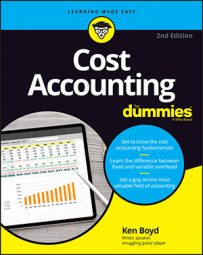In cost accounting, cost-plus pricing is a pricing method that starts with full costs (fixed and variable costs — the entire cost of your product). You then add a percentage markup (that is, a percentage of the costs). Here’s the entire formula for cost-plus pricing:
Proposed selling price = cost base (full costs) + markup
Say you sell vinyl siding for homes. Your cost for a 10-foot unit of siding is $7. You compute a 10 percent markup: ($7 × 10 percent = $.70). Your proposed selling price is shown as follows:
Proposed selling price = cost base (full costs) + markup Proposed selling price = $7 + $0.70 Proposed selling price = $7.70
Reduce your markup in cost accounting
If you have to cut your selling price, it’s easier to reduce markup than to cut costs. So be flexible about that markup. If customers make a judgment that they can buy the same siding for $7.25 a unit, they may buy somewhere else.
You need to consider cutting your selling price and accepting a smaller markup. A $7.25 selling price would be made up of a $7 cost basis and a $.25 markup. That markup is 3.6 percent of cost rather than 10 percent. You’re price-competitive, but at the cost of operating at a lower profit level.
Larger companies with sufficient assets (and especially big cash balances) sometimes accept breaking even for short periods of time. Breakeven means that revenue only covers cost. The product generates $0 in profit.
Often, companies that make it through difficult times end up with more business when things improve. They get new clients — those that previously were dealing with companies that closed.
One of the most important things about being in business is staying in business.
Compute a target rate of return on investment in cost accounting
There are several methods to decide on your markup. Although customer judgments about price and competitor pricing can limit the markup, there’s another view.
Target rate of return on investment is a method you can use to compute a markup. It’s a rate of return on the assets (investment) that you’ve invested in your business. First, consider rate of return on investment (also known as ROI).
Recall that assets exist to make money. You should have some idea about a reasonable rate of return on those assets. After all, you have choices. You can use the same assets to make several different products or provide several different services.
You could also invest those assets in other companies and earn a rate of return. For example, the owner of a men’s and women’s shoe store might wonder if adding a line of sport shoes would have a better ROI than adding a line of children’s shoes.
Say you operate a combination pizza parlor and barbeque restaurant (which is not an impossible fusion). You’ve added $100,000 in capital (cash) to your business. You buy equipment and expand. You base your product decisions on how the $100,000 investment would generate the most profit.
You invest the asset (cash) in equipment, labor, and advertising, finding a good balance between pizza ovens and barbeque equipment. Good news! You earn an additional $10,000. Your incremental rate of return is 10 percent ($10,000 ÷ $100,000).
Now you need to consider whether 10 percent floats your markup boat. To determine a reasonable rate of return, think about the source of your $100,000 in capital. If you borrowed, and if the interest cost was 7 percent on a $100,000 loan, a 10 percent ROI would probably be reasonable. The rate of return is higher than the interest cost.
If you’ve sold an ownership interest in your business, consider what rate of return your investors expect on their investment.
Selling pizza and barbecue together isn’t the strangest restaurant concept in the world. In California, there’s a hot two-store chain called Tex Wasabi’s Rock ‘n’ Roll Sushi BBQ. How’s that for giving customers what they want? It may sound like an odd combination of products, but the company is filling a customer need.
Weigh other issues with cost-plus pricing in cost accounting
Cost-plus pricing is an inexact science. It can be difficult to determine the amount of capital you need for your product, and how to best spend it. Consider the $100,000 in assets in the last section. Converting the $100,000 cash asset to different assets (such as equipment and labor) is an exercise in estimating.
One way to think through your decision is to consider different cost bases and different markups on each cost base. For example, maybe you use variable cost as a cost basis and add a 6 percent markup. Next, you can look at full cost and add a 3 percent markup.
By adding markups and cost bases, you come up with different prices. You can then decide which price is most realistic. By realistic, consider your competition and markup percentage.
In the end, product pricing is about balancing factors. Consider the cost-plus pricing method (cost plus a markup). Balance that against target pricing (setting a price and then estimating costs).

